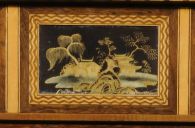No Craftsman is an Island
As mentioned in the previous step, a notable owner of a secrétaire à abattant was the Queen of France, Marie Antoniette. She had a beautiful piece made in 1783, decorated in black and gold Japanese lacquer. The secretary was placed in one of her rooms in Versailles, where she used it to keep safe her collection of Japanese lacquer boxes. (Fig. 2) It is not a coincidence then, that for this step we are zooming in on a small Japanese lacquer plate placed upon our secretary, decorated with an island landscape in black and gold.
Marie Antoniette was not the only appreciator of lacquerware in Europe. European traders had been acquiring Japanese lacquer for the European market since the 16th century, and it was not unusual to find lacquered decorations in European interiors.
Fashion and trends played a big role in the spread of Japanese lacquer in Europe and in the use of fall-front secretaries. In fact, this type of furniture had become popular in the French interiors of the 18th century. In many European countries, Paris was regarded as the capital of luxury design, and dictated the styles which were to be followed. This way, fall-front secretaries came to be popular outside of France as well. It is through this lens that we see our fall-front secretary which was made in the Netherlands, according to French taste.
Interestingly, Paris was the home of numerous furniture makers ( ébénistes) and interior-goods merchants (marchand-merciers), who worked on the ever evolving styles of French interiors. It is important to note that the ébénistes working in Paris were of diverse geographical and cultural origins: many of the craftsmen came from the Netherlands and Germany. Without a doubt, this contributed to the dynamic styles and crafts in 18th century Europe, many of which are embodied in our fall-front secretary, as we will see in the next steps.

](https://micrio.thingsthattalk.net/TTpFv/views/max/128x128.08251b15-4887-4842-bd4d-91675e0645bd.jpg)
](https://micrio.thingsthattalk.net/feysP/views/max/128x128.939437fa-cc99-4200-b3e3-c4b789a80d97.jpg)